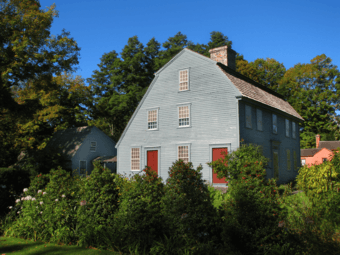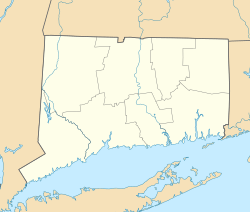Glebe House (Woodbury, Connecticut) facts for kids
|
Glebe House
|
|
|
U.S. Historic district
Contributing property |
|
 |
|
| Location | 49 Hollow Rd., Woodbury, Connecticut |
|---|---|
| Area | 2 acres (0.81 ha) |
| Built | 1746 |
| Architectural style | Georgian |
| Part of | Woodbury Historic District No. 1 (ID71000908) |
| NRHP reference No. | 71000902 |
Quick facts for kids Significant dates |
|
| Added to NRHP | March 11, 1971 |
| Designated CP | March 11, 1971 |
The Glebe House is a really old and important house in Woodbury, Connecticut. It was built around 1740. This house is a great example of the Georgian style of architecture from colonial times. It is also famous because the first election for the Episcopal Church in the United States happened here. Today, it is a historic house museum where you can learn about its history.
The Glebe House was added to the National Register of Historic Places in 1971. You can visit it for tours from May to October. You can also visit by making an appointment.
What Does the Glebe House Look Like?
The Glebe House is located in Woodbury's main village. It stands on Hollow Road, close to Connecticut Route 317. This house is made of wood and has two and a half stories. It has a special roof shape called a modified saltbox profile. This means the back roof slopes down very far.
The front roof has two slopes, which is called a gambrel shape. The back roof also has a gambrel shape, but it curves a little. It extends down to the top of the first floor. The front of the house has five sections with windows and a door in the middle. The front door has a small window above it and a decorative frame. Inside, the house still has many original features. It even has one of the biggest kitchen fireplaces known in Connecticut!
A Look Back: The Glebe House's Story
The Glebe House was built around 1740. It was originally a rectory, which is a home for a church priest. The Rev. John Rutgers Marshall and his wife Sarah lived there. They were the priest and his wife for St. Paul's Church in Woodbury. The Marshalls lived in the house from 1771 to 1785.
A very important event happened at the house on March 29, 1783. Ten church leaders met there for the first Episcopal election in the United States. They chose Samuel Seabury and Jeremiah Leaming as possible candidates. They wanted one of them to become the first Bishop of Connecticut. Leaming was their first choice, but he declined because he was old and not well. So, Samuel Seabury was chosen instead.
After the Marshalls moved out, the house became very run down by the 1920s. In 1923, Edward C. Acheson bought the house. He was a bishop in Connecticut. He created a group called the Seabury Society to save the Glebe House. The house was then restored under the guidance of Henry Watson Kent. He was the Secretary of the Metropolitan Museum of Art.
In 1926, a famous garden designer named Gertrude Jekyll was hired. She designed an "old-fashioned" garden for the newly created museum. Her design included a hedge with flowers and a path leading to the door. She also planned a small, formal garden and six vegetable plots behind the house. There were also narrow flower borders next to the front door.
Explore More
- Jabez Bacon House, another historic house nearby on Hollow Road
- National Register of Historic Places listings in Litchfield County, Connecticut



